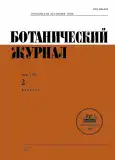STUDIES ON THE EMBRYOLOGY OF CALAMUS PRASINUS (ARECACEAE) – AN ENDEMIC PLANT FROM THE WESTERN GHATS OF KARNATAKA
- Authors: Krishna-Kumar H.N.1
-
Affiliations:
- Department of Studies in Biotechnology Pooja Bhagavat Memorial Mahajana Education Centre PG wing of SBRR Mahajana First Grade College (Autonomous) Affiliated to University of Mysore K.R.S. Road
- Issue: Vol 108, No 2 (2023)
- Pages: 163-170
- Section: COMMUNICATIONS
- URL: https://journals.rcsi.science/0006-8136/article/view/134483
- DOI: https://doi.org/10.31857/S0006813623020072
- EDN: https://elibrary.ru/EXIXET
- ID: 134483
Cite item
Full Text
Abstract
The genus Calamus in the family Arecaceae is embryologically not well studied. The present work on the embryology of Calamus prasinus is the first investigation. A transverse section of young male staminate flower shows 6 tetrasporangiate anthers. The anther wall comprises an epidermis, an endothecium, a middle layer and a tapetum. The tapetum is of secretory type and its cells are 2–3 nucleated. The successive meiotic division in the pollen mother cells resulting in the formation of isobilateral and tetrahedral microspore tetrads. Occasionally, T-shaped and linear tetrads have been observed. The pollen grains are shed at 2-celled condition. The ovary is superior, tricarpellary, syncarpous and contains 3 ovules on an axile placenta. The ovule is anatropous, bitegmic and crassinucellate. The archesporial cell divides periclinally to form a primary parietal cell and a sporogenous cell. The sporogenous cell differentiates transformsin to megaspore mother cell, which undergoes meiotic division and subsequent cytokinesis forming a linear tetrad. The chalazal functional megaspore undergoes three successive mitotic divisions without cytokinesis that results in the formation of an 8‑nucleate embryo sac. The embryo sac contains two synergids, one an egg cell at the micropylar end, three antipodal cells at the chalazal end and a central cell with two polar nuclei. The development of female gametophyte conforms to the Polygonum type.
About the authors
H. N. Krishna-Kumar
Department of Studies in Biotechnology Pooja Bhagavat Memorial Mahajana Education Centre PGwing of SBRR Mahajana First Grade College (Autonomous) Affiliated to University of Mysore K.R.S. Road
Author for correspondence.
Email: hnkrishnakumars@gmail.com
India, Karnataka, Metagalli, Mysore-570 016
References
- Ahmedullah M., Nayar M.P. 1986. Endemic plants of the Indian region Vol. 1. Botanical survey of India. Calcutta. P. 203–204.
- Bailey L.H. 1946. The palm herbarium. – Gentes Herb. 7: 153–180.
- Biradar N.V. 1968. Studies on Palms: Embryology of Phoenix pusila Gaertn., P. acaulis Buch. and P. reclinata Jacq. – Proc. Ind. Acad. Sci. 67: 165–173.
- Biradar N.V., Mahabale T.S. 1968. Studies on Palms: Embryology of Phoenix robusta Hook. – Proc. Ind. Acad. Sci. 67B: 1–8.
- Davis G.L. 1966. Systematic embryology of Angiosperms. New York. 528 p.
- De Poerck R.A. 1950. Contribution a petude de Palmier a huile Africain Elaeis guineensis. – Oleagincux. 5: 623–628.
- Hajra P.K., Sharma B.D., Sanjappa M., Sastry A.R.K. 1996. Flora of Inida-Introductory volume (PartI). Botanical Survey of India, Calcutta.
- Johri B.M., Ambegaokar K.B., Srivastava P.S. 1992. Comparative Embryology of Angiosperms. 2. Berlin. P. 944–950.
- Juliano J.B., Quisumbing E. 1931. Morphology of the male flower of Cocos nucifera L. – Philipp. J. Sci. 45: 449–458.
- International Plant Names Index (IPNI) database https://www.ipni.org/
- Kajale L.B., Ranade S.G. 1953. The embryo sac of Elaeis guineensis Jacq. A reinvestigation. – J. Indian Bot. Soc. 32: 101–107.
- Krishna Kumar H.N. 2021. Embryology of Dypsis decaryi (Arecaceae). – Bot. Zhurn. 106 (9): 898–901.
- Krishna Kumar H.N., Ramaswamy S.N. 2004. Studies on the Distributional and Phenological aspects of Calamus L. in Karnataka. – Indian Forester. 130 (2): 224–230.
- Krishna Kumar H.N., Ramaswamy S.N. 2003. Contributions to the Study of Microsporogenesis in Calamus L. (Arecaceae). – Taiwania. 48 (3): 180–193.
- Kulkarni K.M., Mahabale T.S. 1974. Studies on Palms: Embryology of Livistona chinensis R. Br. – Proc. Ind. Acad. Sci. 67: 1–17.
- Lakshmana A.C. 1993. Rattans of South India. Evergreen Publishers, Bangalore. 178 p.
- Mahabale T.S., Chennaveeraiah M.S. 1957. Studies on Hyphaene indica Becc. I. Morphology. – Phytomorphology. 7: 184–194.
- Mahabale T.S., Biradar N.V. 1968. Studies on palms: Embryology of Phoenix sylvestris Roxb. – Proc. Ind. Acad. Sci. 67 (2)B: 77–96.
- Maheshwari P. 1950. An introduction to the Embryology of Angiosperms. New York, London. 453 p.
- Quisumbing E., Juliano J.B. 1927. Development of Ovule and Embryo sac of Cocos nucifera. – Bot. Gaz. 84: 279–293.
- Rao C.V. 1959a. Contributions to the embryology of Palmae I. Sabaleae. – Proc. Nat. Inst. Sci. India. 29: 134–164.
- Rao C.V. 1959b. Contributions to the embryology of Palmae II. Ceroxylineae. – J. Indian. Bot. Soc. 37: 47–75.
- Renuka C. 1992. Rattans of Western Ghats. A taxanomic manual. Kerala Forest Research Institute, Peechi, Kerala.
- Robertson B.L. 1976a. Embryology of Jubaeopsis caffra Becc. 1. Microsporangium, Microsporogenesis and Microgametogenesis. – J. S. Afr. Bot. 42: 97–108.
- Schnarf K. 1931. Vergleichende Embryologie der Angiospermen. Gebruder Borntraeger, Berlin. P. 279–280.
- Shirke N.S., Mahabale T.S. 1972. Studies on palms: Embryology of Caryota urens L. – In: Advances in Plant Morphology. Sarita Prakashan, Meerut. P. 218–232.
- Takhtajan A. 1987. Systema Magnoliophytorum. Moscow. 439 p. (In Russ.).
- Uhl N.W., Dransfield J. 1987. Genera Plamarum. Allen Press, Lawrence, Kansas, USA.
Supplementary files














